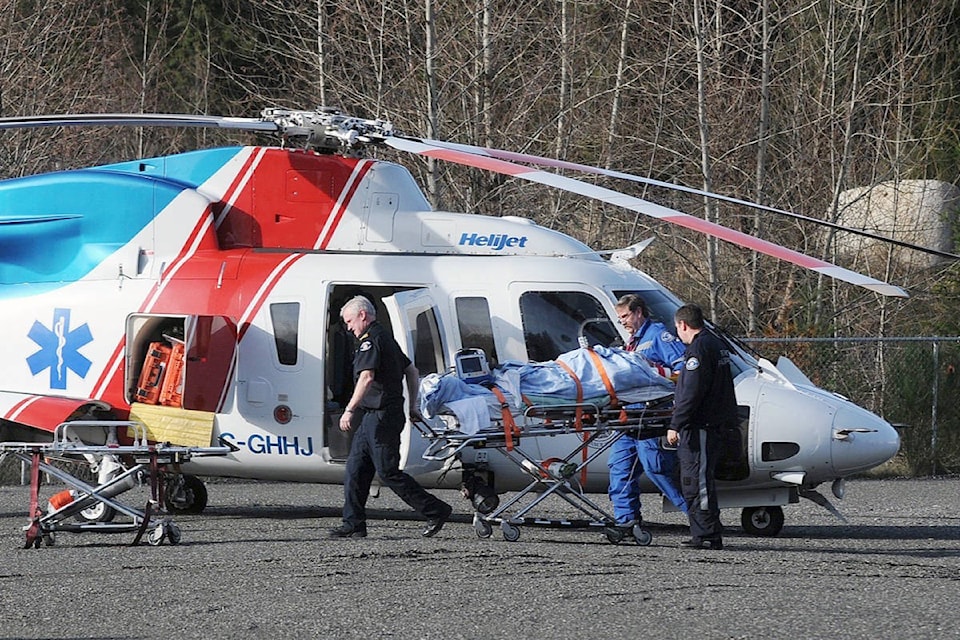Months after the fatal Humboldt Broncos bus crash, an air ambulance advocacy group is sounding the alarm about what would happen if a similar crash occurred in rural B.C.
“Our first responders would be hard-pressed to deal with a situation of multiple severe injuries,” Ted Clarke, president of the B.C. Helicopter Emergency Rescue Operations Society, said in a news release.
“That’s because none of our [advanced life support] paramedics are based in rural areas. There’s no provision to bring doctors to the scene because it is illegal for them to work outside of hospitals and there’s no way to get advanced medical care to a remote accident scene quickly because B.C. lacks a properly equipped rapid-response air ambulance system.”
The society has called on the provincial government to change its emergency medical system for decades, and to mirror rapid-response systems like in Alberta, Manitoba and Saskatchewan, where doctors are taken to the scene of an accident and firefighters can drive ambulances, for example.
Helicopters, airplanes or, in congested areas, fast cars that could bring in specialists or advanced paramedics to stabilize sick or injured patients would save more lives, the society said.
The group is also calling for a complete overhaul to B.C.’s “pre-hospital” system, which it estimates would cost each British Columbian five cents per day, or $18 per year, to hire 2,500 more advanced life support paramedics, buy 200 more ambulances, set up 50 more ambulance stations, and create teams of multi-specialty doctors and nurses to provide care at a crash scene.
“We need to cut down on the vacuum of inactivity between time of injury and time of intervention,” said Dr. Marietjie Slabbert, medical advisor with B.C. HEROS.
“This is the only way to save lives. From the moment you are injured or become critically ill, the clock is ticking and the time to save your life is running out.”
Saskatchewan’s response to bus crash
Sixteen people died and 13 were injured after a bus carrying the Humboldt Broncos junior hockey team collided with a tractor trailer along a stretch of highway south of rural Saskatchewan on April 6.
Hospitals were given a “code orange,” meaning numerous patients would be arriving at the same time. Meanwhile, a mix of air ambulances from Saskatchewan Air Ambulance, the department in charge of major air transports in the province, and Transwest Air, the department that takes care of transporting lower acuity patients, flew the people to hospitals in Nipawin, Tisdale and Melfort.
Two fixed wing critical care-capable air ambulances from Alberta Air Ambulance and the non-profit organization STARS air services were also used.
B.C. has responded to mass-casualty events before
Linda Lupini, executive vice-president with BC Emergency Health Services, disagreed that B.C. is not capable of handling mass-casualty events, saying in fact it has done so four times in the last four years.
In February, emergency crews responded to a major crash along the Coquihalla Highway near Hope that involved two buses, two tractor trailers and passenger vehicles that in total involved 165 patients.
Twenty-nine ground and air ambulances were deployed, Lupini said, as well as three paramedic responder vehicles and six supervisor vehicles.
“What we do then, is a complex network of who is the sickest, who is the most injured and what is the quickest way to get them to definitive care,” Lupini said in an interview with Black Press Media, adding that could mean by helicopter, ambulance, or a mix of both to a hospital.
“It’s about speed in some cases – is it faster to take a ground ambulance to an airport to get them to Vancouver with our fixed wing? Or is it faster to helicopter them to an airport? All of that is being coordinated by the dispatch.”
A helicopter crew with the Royal Canadian Air Force Rescue Squadron 442 was dispatched, but paramedics on scene cancelled the request upon further assessment of the patients.
INVESTIGATIVE SERIES: Critical condition in rural B.C.
A total of 29 patients were taken to hospital, with injuries ranging from stable to critical. The other 139 people were assessed at a warming centre in Hope.
BC EHS operates 11 air ambulances and a ground fleet of nearly 700 vehicles, as well as 45 pre-qualified resources to be called on if needed.
Lupini said if necessary, paramedics can use the EPOS program, or Emergency Physician Online Support Service, to access direct advice 24/7 from emergency physicians, trauma surgeons, anesthesiologists and other specializations.
“We have 72 critical care paramedics, the highest level of paramedic training,” she said. “Critical care paramedics can do things that physicians can do – they have done amputations out in the field, they do intubation, they do all kinds of life-saving techniques.”
These paramedics are strategically placed around B.C., including in Kelowna, Nanaimo and Abbotsford, and are brought into areas in emergencies.
While no one died in the February crash, Lupini said this was one example of using the resources available from multiple jurisdictions surrounding the rural stretch of road.
“The idea that other jurisdictions use charitable foundations and physicians is a model – it’s not a model we want in B.C.”
A provincial system that allows crews to share resources is preferable, she said, because ambulances and paramedics are not bound by community borders, and can support others particularly in rural and remote locations.
The provincial dispatch centres can allocate resources across the province as needs arise, she added.
Since the election, Health Minister Adrian Dix has announced the hiring of 30 paramedics in the mid-Vancouver Island and 21 serving in northeastern B.C., the central Interior and Castlegar, in the West Kootenay.
@ashwadhwani
ashley.wadhwani@bpdigital.ca
Like us on Facebook and follow us on Twitter.
